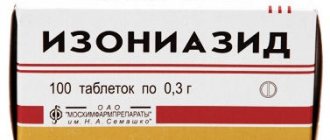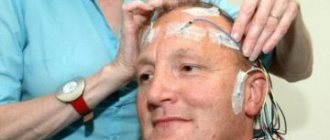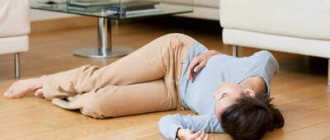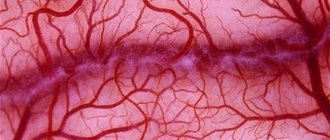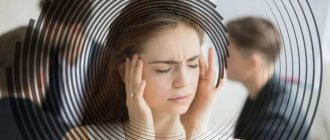Paroxysmal states. Fainting
Fainting , or syncope, is an attack of short-term loss of consciousness and impaired muscle tone of the body (fall) due to a disorder of cardiovascular and respiratory activity. Syncope conditions can be neurogenic in nature (psychogenic, irritative, maladaptive, dyscirculatory), develop against the background of somatic pathology (cardiogenic, vasodepressor, anemic, hypoglycemic, respiratory), under extreme influences (hypoxic, hypovolemic, intoxication, medication, hyperbaric). Syncope, despite its short duration, is a process unfolding over time, in which successive stages can be distinguished: precursors (presyncope), peak (syncope itself) and recovery (postsyncope). The severity of clinical manifestations and the duration of each of these stages are very diverse and depend mainly on the pathogenetic mechanisms of fainting.
Fainting can be provoked by an upright position, stuffiness, various stressful situations (unpleasant news, blood drawing), sudden acute pain. In some cases, fainting occurs for no apparent reason. Fainting can occur from once a year to several times a month.
Clinical manifestations . Immediately after the provoking situation, a presyncope (lipothymic) state develops, lasting from several seconds to several minutes. At this stage, severe general weakness, unsystematic dizziness, nausea, flickering of “spots”, “veils” before the eyes are observed, these symptoms quickly increase, there is a premonition of a possible loss of consciousness, noise or ringing in the ears. Objectively, during the lipothymic period, pallor of the skin, local or general hyperhidrosis, decreased blood pressure, pulse instability, respiratory arrhythmia are noted, coordination of movements is impaired, and muscle tone decreases. The paroxysm can end at this stage or move into the next stage - the actual syncope state, in which all the described symptoms increase, the patients fall, and consciousness is impaired. The depth of loss of consciousness varies from slight stupefaction to deep disturbance lasting several minutes. During this period, there is a further decrease in blood pressure, shallow breathing, the muscles are completely relaxed, the pupils are dilated, their reaction to light is slow, and tendon reflexes are preserved. With a deep loss of consciousness, short-term convulsions, often tonic, and involuntary urination may develop. In the post-syncope period, the restoration of consciousness occurs quickly and completely, patients immediately orient themselves in the environment and what happened, and remember the circumstances preceding the loss of consciousness. The duration of the post-syncope period ranges from several minutes to several hours. During this period of time, general weakness, non-systemic dizziness, dry mouth are noted, pale skin remains, hyperhidrosis, decreased blood pressure, and uncertainty of movements.
The diagnosis is made on the basis of a carefully collected anamnesis, examination of somatic and neurological status; all patients with syncope must undergo echocardiography, VEM, Echo-CG, 24-hour blood pressure monitoring, EEG, ultrasound, radiography of the cervical spine, EEG and EEG monitoring
a single treatment regimen for patients in the interictal period, since the causes and pathogenetic mechanisms of development of various variants of syncope are very diverse. Treatment is prescribed only after a thorough examination of the patient and substantiation of the diagnosis not only of the underlying disease, but also clarification of the leading pathogenetic mechanisms of the development of fainting.
Classification of syncope
According to the pathophysiological mechanism, fainting conditions are classified according to the following scheme:
- Neurogenic syncope - reflex, vasovagal, typical, atypical, situational when sneezing or coughing, with trigeminal neuralgia.
- Orthostatic - caused by a lack of autonomic regulation, with secondary insufficiency syndrome, post-exertion, postprandial (after eating), caused by medications, alcohol intake, diarrhea.
- Cardiogenic syncope - arrhythmogenic, caused by disruption of the sinus node, tachycardia, rhythm disturbance, functioning of defibrillators, due to the action of medications, diseases of the cardiovascular system and arteries.
- Cerebrovascular - due to a sharp narrowing or blockage of the subclavian vein.
- Non-syncope with partial loss of consciousness - they can be caused by metabolic disorders, epilepsy, intoxication, ischemic attacks.
- Non-syncope without loss of consciousness - cataplexy, pseudosyncope, panic attacks, ischemic conditions, hysterical syndrome.
Vasodepressor syncope occurs due to disruption of the heart and begins with an increase in tone and an increase in pressure. Orthostatic fainting is common in older people and is caused by instability of vasomotor function. Every fifth syndrome is cardiogenic, occurring due to a decrease in stroke volume of the heart. Cerebrovascular conditions occur due to hypoglycemia and medications.
- Cutlets in the oven - step-by-step recipes with photos. How to cook delicious dietary minced meat cutlets
- Tomatoes in gelatin for the winter recipes with photos without sterilization
- Birch mushroom - beneficial properties and applications. How to brew and drink birch chaga, contraindications
Treatment
Treatment of syncope in medicine is carried out using specific drugs. In case of syncope associated with severe hypotension, 1 ml of metazone (1%) or 2 ml of cordiamine is injected intramuscularly. Sometimes therapy may include subcutaneous injection of 1 ml of caffeine (10%). Further treatment options for the patient depend on the causes of the disease. Therapy for syncope is aimed at preventive measures that reduce neurovascular excitability and increase the stability of the mental and autonomic systems.
To regulate mental conditions, the doctor prescribes psychotropic medications, the course of treatment of which is at least 2 months. Antelepsin, Grandoxin, and Seduxen tablets help eliminate anxiety. A person should carefully monitor the general condition of his body. Regularly spend time in the fresh air, use moderate physical activity, ensure proper rest, monitor your work schedule, and monitor the level of systemic blood pressure.
To correct autonomic disorders, breathing exercises, taking B vitamins, vasoactive drugs, and nootropics are indicated. If syncope is caused by cardiac pathological processes, then drugs that improve coronary blood flow are prescribed: atropine, cardiac glycosides. Depending on the cause of loss of consciousness, anticonvulsant medications may be used. Hospitalization after syncope is reserved for patients who:
- repeated attacks;
- there is a disturbance in cardiac activity before fainting;
- poor family history;
- fainting occurs when lying down;
- injured after syncope;
- acute neurological symptoms;
- the presence of myocardial ischemia;
- the attack is caused by an arrhythmia.
First aid for syncope
People should be aware that competent emergency care for fainting may not always be provided. To avoid injury, you need to be able to recognize in advance the mechanisms of syncope: squeaking in the ears, flies flashing before the eyes, nausea, dizziness, profuse sweating, a feeling of general weakness. If such changes in health status are recorded, follow a number of simple steps:
- Lie on a flat surface, raise your legs 40-50 degrees;
- Loosen tight clothing and allow air flow;
- Massage the dimple on the upper lip and temple area;
- Inhale the ammonia vapor.
If a person has already lost consciousness, then those around him perform the following actions:
- Lay the victim on his back so that his head and torso are at the same level. Turn your head to the side so that your tongue does not interfere with the breathing process.
- Open doors or windows to allow oxygen to flow. Ask to free up space around the patient, unfasten the buttons of clothing.
- To activate the vasomotor and respiratory centers, irritation of skin receptors is necessary. To do this, rub the person’s ears, splash his face with cold water, and pat his cheeks.
Etiology and pathogenesis
The causes of syncope are reflex, orthostatic, cardiogenic and cerebrovascular. The following factors influence the development of syncope:
- tone of the blood vessel wall;
- systemic blood pressure level;
- person's age.
The pathogenesis of different types of syncope syndromes is as follows:
- Vasovagal syncope - syncope or vasodepressor states - occurs due to disorders of the autonomic regulation of blood vessels. The tension of the sympathetic nervous system increases, causing blood pressure and heart rate to increase. Subsequently, due to increased tone of the vagus nerve, blood pressure drops.
- Orthostatic syncope occurs most often in older people. They increasingly show a discrepancy between the volume of blood in the bloodstream and the stable functioning of vasomotor function. The development of orthostatic syncope is influenced by the use of antihypertensive drugs, vasodilators, etc.
- Due to a decrease in cardiac output, cardiogenic syncope develops.
- cerebrovascular develops . Elderly patients are also at risk due to the likelihood of developing transient ischemic attacks.
Mental illness and age over 45 years increase the frequency of recurrent syncope.
Causes of fainting
Of primary importance in the development of fainting is a decrease in systemic blood pressure, which leads to a deterioration in cerebral blood flow. In this case, a decrease in systemic blood pressure may develop due to a decrease in cardiac output and total peripheral vascular resistance. Thus, with insufficiency of the autonomic system, sympathetic nerve fibers are not able to increase the total peripheral vascular resistance when moving to a vertical position (orthostasis intolerance syndrome). Reasons for a transient decrease in cardiac output: 1. – reflex bradycardia (slow pulse); asystole (cardiac arrest), which is accompanied by fainting; hypersensitivity of the carotid sinus; 2. – cardiovascular diseases, including arrhythmias, for example: dysfunction of the sinus node and atrioventricular junction; 3 – inadequate venous return associated with a decrease in circulating blood volume and blood deposition in the veins.
Features of the clinical picture
Features of the clinical course of different types of syncope are as follows:
- Vasovagal or vasodepressor syncope occurs due to stress, a person being in stuffy rooms, when exposed to a pain factor, etc. Also predisposing factors for the development of this condition are blood loss and hyperthermia. Before the attack itself, nausea, abdominal pain, etc. may occur.
- Orostatic syncope is manifested by a feeling of dizziness and nausea. When the body returns to a horizontal position, such symptoms usually disappear. During the first three minutes after the body moves to a vertical position, there may be dizziness and even loss of consciousness.
- With cardiogenic syncope, before loss of consciousness, the patient often feels weakness and chest pain. Loss of consciousness often occurs when a person sits or stands for a long time.
- As already noted, cerebrovascular syncope accompanies conditions such as hypoglycemia, oxygen starvation, etc. In some cases, a person experiences symptoms such as double vision, dizziness, and impaired visual acuity.
Tactics and strategy for providing assistance
The choice of treatment tactics primarily depends on the cause of syncope. Its purpose is, first of all, to provide emergency care, prevent repeated episodes of loss of consciousness, and reduce negative emotional complications.
First of all, in case of fainting, it is necessary to prevent the person from hitting himself. He needs to be laid down and his legs placed as high as possible. Tight clothing should be loosened and sufficient fresh air should be provided.
You need to give ammonia to sniff and spray your face with water. It is necessary to monitor the person’s condition, and if he does not wake up within 10 minutes, call an ambulance.
In case of severe fainting, Metazon in a 1% solution or Ephedrine in a 5% solution are administered orally. An attack of bradycardia and fainting is stopped by the administration of Atropine sulfate. Antiarrhythmic drugs should be administered only for cardiac arrhythmias.
If the person comes to his senses, you need to calm him down and ask him to avoid the influence of predisposing factors. It is strictly forbidden to give alcohol or allow overheating. Drinking plenty of water with added table salt is beneficial. It is necessary to avoid sudden changes in body position, especially from a horizontal to a vertical position.
Therapy between attacks is limited to taking recommended medications. Non-drug treatment boils down to the abolition of diuretics and dilators. In case of hypovolemia, correction of this condition is indicated.
Prevention and recommendations
Even healthy people can briefly lose consciousness as a result of a pressure surge, so there are general recommendations for solving the problem:
- avoid emotional stress and stressful situations;
- lead an active lifestyle, but avoid physical overload;
- follow the rules of a healthy diet, maintain water balance;
- to refuse from bad habits;
- be sure to get enough sleep and follow a daily routine;
- do not change your body position too sharply;
- do not leave home without medications prescribed by a doctor;
- Do not ignore presyncope symptoms.
Among the measures to prevent syncope, the first priority is the need to avoid situations that can cause it. Good results are achieved by timely identification and treatment of diseases that are the root causes of fainting. Monitoring blood pressure levels is also necessary.
Syncope is quite dangerous, as it involves oxygen starvation of all body systems. If you periodically lose consciousness, see your doctor for an evaluation to rule out life-threatening illnesses.
Diagnostics
To determine the cause of syncope, invasive and non-invasive diagnostic methods are used. They differ in the type of conduct and methods of diagnosis:
- Non-invasive options - carried out on an outpatient basis, include collection of anamnesis, tests, physical examination of the patient’s characteristics, and laboratory research methods. Procedures include ECG (electrocardiogram), exercise test, tilt test (orthostatic test), carotid sinus massage, echocardiography, electroencephalography, radiography. Doctors can use CT (computed tomography) and MRI (magnetic resonance imaging), the patient is sent to an ophthalmologist or psychiatrist.
- Invasive - they need to be carried out in a hospital, used in the presence of signs of cardiovascular diseases confirmed by non-invasive methods. Methods for diagnosing syncope include electrophysiological studies, cardiac catheterization, coronary angiography, and ventriculography.


